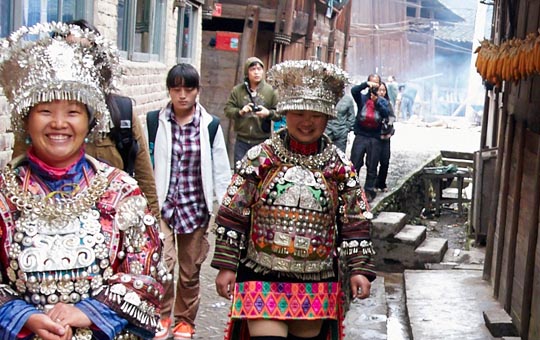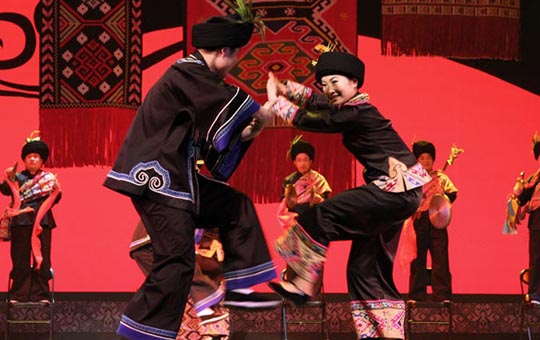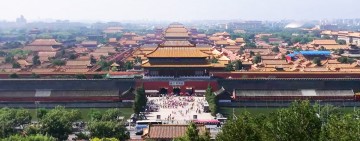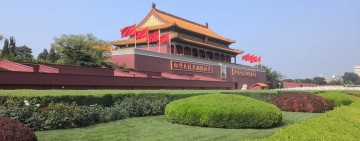Chinese Ethnic Groups
Dernière mise à jour le 1970-01-01China officially recognizes 56 ethnic groups, including the Han majority. These groups are incredibly culturally diverse; fifty-three ethnic groups have their own language and 23 have their own written language.
Approximately 8.4% of the Chinese population belongs to an ethnic minority group (i.e. not the Han majority). Put together, that is 111 million people, enough to be the 12th most populous country in the world! Minorities make up the population of 60% of China’s territory, mainly in Tibet and Xinjiang. About 8% of the Beijing population (800,000 people) belongs to an ethnic minority, most of whom are Mongolian or Manchurian. However, most minorities live in border areas rather than in major cities or interior regions.
The largest ethnic groups: The Han and Zhuang
Han Chinese represent more than 90% of China’s population and roughly 20% of the world’s population, around 1.1 billion people. Han Chinese derive from the Han Dynasty, which ruled for 400 years, making it the longest-ruling empire in China’s history. Most Han speak Mandarin.
After the Han, the biggest ethnic group is the Zhuang, with 18 million people. The Zhuang people are mostly concentrated in the Guangxi Zhuang Autonomous Region in southern China. Although the Zhuang have their own language, most of them speak Chinese dialects.
Muslim ethnic groups: The Hui and the Uyghur
There are two major Muslim ethnic groups in China: the Hui and the Uighurs. There are 10.5 million Hui and 10 million Uighurs in China.
The Hui are concentrated in Ningxia Hui Autonomous Region in northwest China and also spread out across Xinjiang. The Hui practice Islam and are descendants of the Turks like the Uighurs, however, unlike them, they didn’t retain a Turkish dialect and mostly speak Mandarin. In some sense, the Hui are unique because they represent the only ethnic group in China for which religion is the only unifying criterion of identity. The vast majority of the Hui speak Mandarin and have the same dietary preferences as the Han, but refrain from eating pork, which is the most common meat consumed in China. The Hui have largely assimilated into Han society and have adapted their Islamic practices to fit into the Confucian-influenced culture. Hui mosques blend traditional Chinese dynastic architecture with Islamic motifs.
The Uighurs, on the other hand, account for more than half of all Muslims in China. They are distant relatives of the Turks and their language belongs to the Turkic group of the Altaic branch. Their written language is based on Arabic characters. Uighur means “unity” or “alliance” and they’re mostly settled in China’s northwestern territory, namely the Xinjiang province.
China’s most skilled equestrians: The Manchu and the Mongols
Another of the largest ethnic groups is the Manchu, with over 10 million people. Manchuria is a region of northeastern China that encompasses Heilongjiang, Jilin, and Liaoning provinces. Manchuria has a long history both as a conqueror and conquest of China. Their ancestry can be traced back more than 2,000 years to the Sushen tribe, and later to other tribes native to the Changbai Mountains such as the Yilou, Huiji, Mohe, and Nuzhen.
Manchu men and women were excellent equestrians and archers, and young children were taught to hunt swan with bows and arrows by the age of six or seven, while teenagers learned to ride on horseback in full hunting gear.
The very last emperor of China, Henry Pu Yi was a Manchu.
Today, only a handful of elderly people in the most remote corners of northeast China still speak the Manchu language, which belongs to the Manchu-Tungusic group of the Altaic language family. As for the rest of the Manchus, they speak Mandarin like the Han.
Also found in northern China are the Mongols. The Mongolians mainly live in the Inner Mongolia Autonomous Region, with others scattered around Liaoning, Jilin, Heilongjiang, Xinjiang, Hebei, and Beijing.
More than 21 million people live in the Inner Mongolia Autonomous Region, 2 million of whom are Mongolians. Many others belong to minorities such as Hui, Manchu, Daur, Ewenki, Oroqen, Koreans, and Han.
Mongol was the name of a tribe roaming along the Erguna River. The Mongols moved through the grasslands of western Mongolia in the 7th century until they settled in the upper reaches of the Onon, Kerulen and Tula Rivers and areas east of the Kentey Mountains in the twelfth century. Many tribes stemmed from the Mongols, including the Tartar, Wongjiqa, Mierqi, and Kelie around Lake Baikal.
History knows about the Mongols thanks to some of their most formidable rulers, such as Temujin, who unified the Mongol tribes, and was awarded the title of Genghis Khan in 1206. Another prominent Great Khan was Kublai Khan, who in 1272 founded the Yuan Dynasty, which would rule China from 1206 to 1368.
As a result, Mongolians have been credited as great contributors to Chinese culture.
Modern day Mongolians still pride themselves in their horsemanship and archery skills, and some are experienced wrestlers. Between July and August each year, Mongolians have a chance to demonstrate their athletic abilities during the Nadam fair.
Tibet: From Dalai Lamas to the smallest ethnic group
Tibetans are one of the most recognizable ethnic groups in China. There are about 6.2 million Tibetans in China, out of which 2.1 million live in Tibet, while the rest are spread in the bordering provinces, such as Yunnan, Gansu, Sichuan and Qinghai.
Since Tibetans live in vast grasslands and near important water resources, their main activity is animal husbandry. Tibet is famous for Mount Everest, known to Tibetans as Qomolangma, the tallest mountain in the world, standing at 8,848 meters above sea level.
The Tibetan language belongs to the Tibetan sub-branch of the Tibeto-Burman language branch of the Chinese-Tibetan language family, and there are three major local dialects based on geographical divisions, which are the Weizang, Kang, and Amdo.
Dalai Lamas are the best known Tibetans in the world. Dalai Lama is the title given to monks of the Gelug or Yellow Hat school of Tibetan Buddhism. They are the Tibetan’s spiritual leaders. The Dalai Lama title was created by Altan Khan under the Ming Dynasty in 1578. Currently, Tenzin Gyatso is the fourteenth Dalai Lama.
Tibetan families are mostly male-centered and marriage is a strictly inner-class affair. Marriage is forbidden for the Yellow Hat order monks, while those monks belonging to other religious sects are free to marry.
The Tibet Autonomous Region is also home to the smallest minority in China, the Lhoba, comprising only 2,965 people. They are concentrated in the Mainling, Medong, Lhunze and Nangxian counties in southeastern Tibet, and a handful of them also live in Luoyou, South Tibet.
Throughout their history, the Lhoba were discriminated and even oppressed by the Tibetan local government, manorial lords and monasteries during the serfdom in Tibet. They weren’t allowed to leave their areas without permission, couldn’t do business with other ethnic groups and were forbidden to marry outside of their ethnic group.
They have no written script and used to be a hunting and fishing society. Nowadays, their livelihoods are slowly improving and many of them are now farmers and don’t need to rely on hunting anymore. However, men who kill black bears, wild boars, bison and other big animals, are greatly respected.
Ethnic minorities in Southern China: Miao and Yi

One of the largest ethnic minorities in southwest China is the Miao, with a population of 8.9 million. The Miao mainly live in Guizhou, Yunnan, Hunan and Sichuan provinces as well as in the Guangxi Zhuang Autonomous Region. Some Miao also live in the Hainan Island in Guangdong province and in southwest Hubei province. Two thousand years ago, the ancestors of the Miao could be found in western present-day Hunan and in the east of present-day Guizhou.
Their language belongs to the Miao-Yao branch of the Chinese-Tibetan language family, and has three main dialects, one based in west Hunan, one in east Guizhou and the other in Sichuan, Yunnan and part of Guizhou.
About 100,000 Miao speak a Chinese dialect in Hunan, Guangxi and Guizhou; in another region in Guangxi, over 30,000 Miao speak the Dong language, while more than 100,000 people in Hainan Island speak the language of the Yaos.
The Miao have some unique marriage customs. While marriages are usually arranged, men and women are free to pursue their own lovers. The Miao also practiced the “kidnapping bride” tradition. If the kidnapped girl consented to the marriage, there would be a wedding feast, but if she refused, she’d be free to go.
Since the Miao are so diverse, their festivities are also different for each group, and fall in different dates.
Also living in Sichuan, Yunnan and Guizhou provinces and the Guangxi Zhuang Autonomous Region are the Yi, who also inhabit some parts of Thailand and Vietnam. Out of 7.7 million Yi, 2.2 million live in Liangshan, Sichuan province, which makes it the largest nationality in the Autonomous Prefecture.
The Yi language belongs to the Tibeto-Burman language group of the Chinese-Tibetan language family. The Yi speak six dialects.
The Yi people practice Bimoism, and place a heavy importance in ancestor worshipping. Unlike most of other religious traditions in China, the Yi of Liangshan lack temples.
While other minorities consider their men and women as equal, the Yi follow strict gender norms. Women are devoted to spinning and weaving, while men are the only ones who can felt.
The Yi have been notorious for a long time. Sima Qian, a Western Han Dynasty era academic, known as the “father of Chinese historiography” and Xu Xiake, famous for traveling with Marko Polo, visited the Yi in Liangshan in the ancient times.
One famous Yi is female singer Jike Junyi, who became an instant hit after performing in The Voice of China in 2012.
Tujia: one of China’s most creative ethnic groups

And while Jike Junyi may be notorious for her singing, another minority, the Tujia, are known for their creativity. There are 8.3 million Tujia in China but only 70,000 speak the Tujia language, while the rest speak the Miao language or Mandarin. The Tujia are famous for their singing and song composing skills.
One of their most famous dances is the bai shou, a 500-year old collective dance that uses 70 ritualistic gestures to represent war, farming, crocheting and a myriad of other aspects of the traditional life.
The Tujia live in the Wuling Range in western Hunan and in the Hebei province.
Some of China’s most unique ethnic groups
Each minority group in China is a whole different world, and while the ones listed here are only the largest groups, there are many others that deserve an honorary mention.
There are more than 2,6 million Yao in China, and one particular group of 400 people nestled in the Huangluo Village in Guangxi, is known for its women. Specifically for their women’s long, jet black hair that can grow up to 2.1 meters.
The Red Yao women in Huangluo value their hair so much that they only cut it once in their whole lives, when they turn eighteen. And even then, they don’t discard it like it’s nothing, instead passing it down to their grandmothers and made into an ornamental headpiece. Once the woman has found a suitable husband, the hair is gifted to the groom, and later becomes part of her every day hairdo.
As recent as the 80s, no man outside a woman’s family was supposed to see a Red Yao woman’s hair loose. If they did, they were forced to spend three years with the woman’s family as their son-in-law. These days the Red Yao women, are happy to show their beautiful hair to tourists, and even reveal one of their beauty secrets, which is washing their hair with fermented rice water.
Red Yao women’s hair is also indicative of her marital status. If their hair is covered, that means that the lady is single and actively looking for a husband. If a woman wears her hair wrapped in a circular tray on top of her head, it means she’s married but has no children. A bun at the front of her wrapped hair means she has children.
Far from the Red Yao women, in the far eastern foothills in the Himalayas in Yunnan, lives another group also known for its women. They are the Mosuo, a tribal community of Tibetan Buddhists. The Mosuo women rule, literally.
Women inherit properties and sow crops, while also running their households. Men on the other hand, provide the strength needed to repair homes, slaughtering animals and helping the family with big decisions. However, it’s the Grandmother of the house who has the last word.
Marriage is an alien concept to Mosuo people. Instead they practice something called “walking marriage”, which is basically a nocturnal hook-up with lovers known as “axia”. A hat hung from a woman’s house is an indication that no other men are welcome. Some Mosuo women stay single their entire life, while some others choose a single man as their life-long partner.
It’s not uncommon for Mosuo women not to know who their children father is; but in their society this is hardly anything to frown at, as their elderly maternal great-uncles, who are often the second-in-charge in their homes, as well as younger uncles play a major role in the children’s upbringing.
Lastly, the women from the Dulong ethnic group, who mainly live in the Dulong River Valley in the Gongshan Dulong and Nu Autonomous County in Yunnan province, are known for their tattooed faces.
There are only 28 tattooed Dulong women left in China, since the face tattooing practice was abolished after the founding of the People’s Republic of China in 1949. Prior to this change in the law, the women would tattoo their faces when they reached 12 or 13 years of age.
These are the other minorities in China in alphabetical order: Achang, Bai, Blang, Bonan, Bouyei, Chaoxian, Dai, Daur, Deang, Dong, Dongxiang, Dulong, Ewenki, Gaoshan, Gelao, Gin, Hani, Hezhen, Hui, Jingpo, Jino, Kazak, Kirgiz, Lahu, Li, Lisu, Man, Maonan, Miao, Monba, Mulam, Naxi, Nu, Orogen, Primi, Qiang, Russ, Salar, She, Shui, Tagik, Tatar, Tu, Uzbek, Wa, Xibe, Yugur, and Zang.




